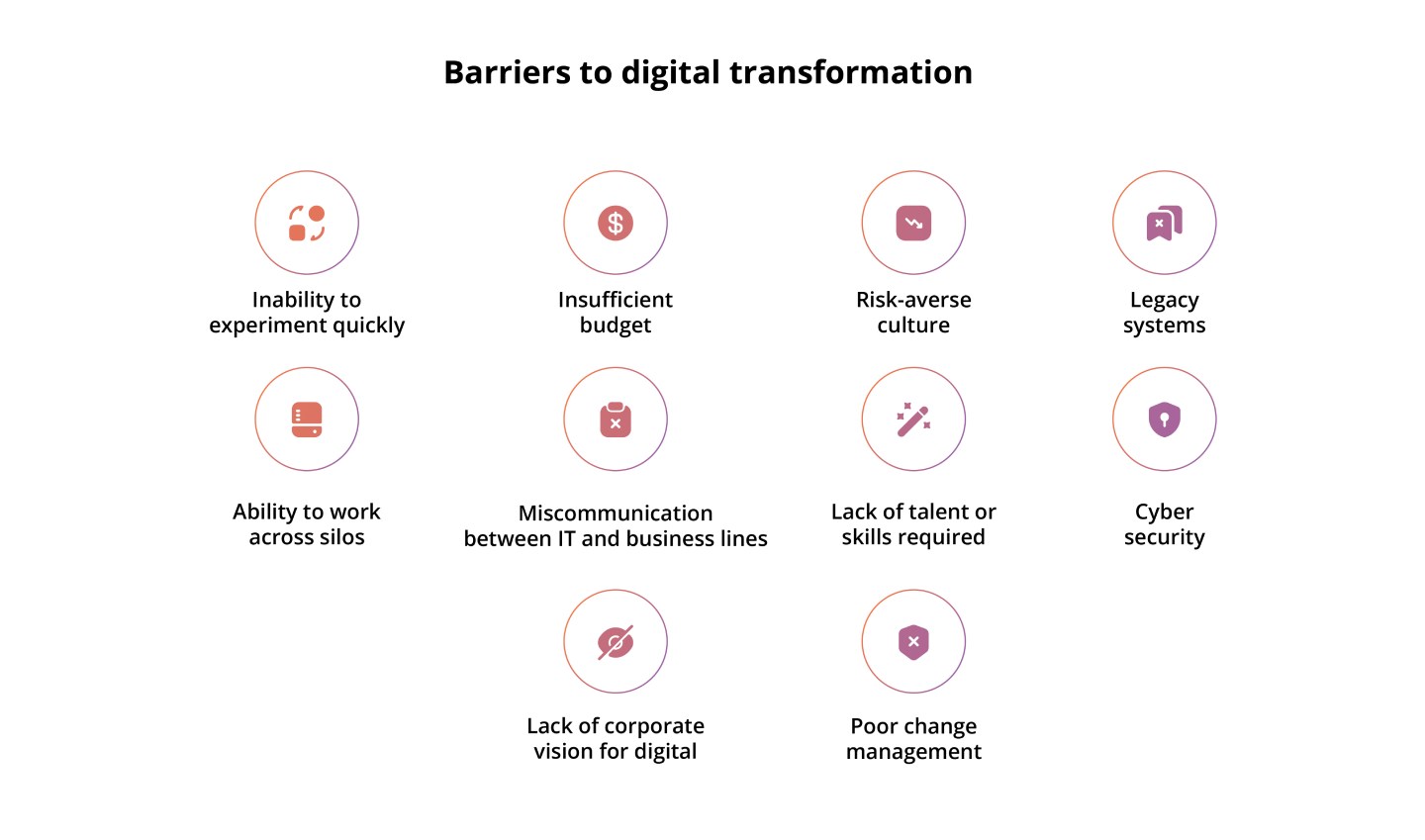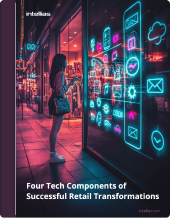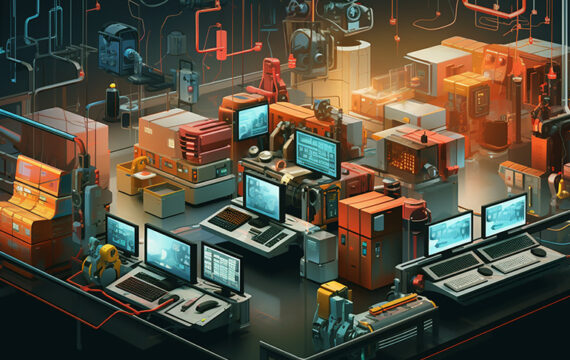Today, many retail businesses are almost unrecognizable from what once defined them. Some have embraced the opportunities provided by modern technology to build customer loyalty and find new markets at home and abroad. Others are struggling to keep pace with technological changes, while some have given up the fight altogether.
But what unites all retailers is their embrace of data and new technology in retail to offer a broader set of products and services to both consumers and other businesses through multiple channels. What separates them is their willingness or ability to change in ways that enable them to keep pace with consumers, confront competition from new territories and new players, and turn a profit even as their costs rise due to higher wages and regulatory burdens.
This report seeks a new definition of retail, as success today and in the future depends on an understanding of how companies should adopt – as well as modify and adapt – technology to better take advantage of the opportunities afforded by trading through multiple channels and offer more services to consumers with higher-than-ever expectations. But this is not only about retail technology – it is about the whole system’s architecture as well as clean, harmonized data that can be applied across the entire business.
What’s wrong with the current definition of retail?
“Retail is the activity of selling goods direct to the public.”
Based on this narrow definition, we can see that modern retail is patently different from what it once was. Retail now embraces wholesale and business-to-business and uses multiple channels to sell both directly and through third parties. Retailers even sell their own services to both consumers and businesses, such as logistics, warehousing, and supply chain management.
While retail as it is traditionally defined may lie at the heart of many businesses today, the growing number of related and unrelated companies surrounding it is something altogether different, as retailers seek to communicate their values to their customers in more substantial and profitable ways.
- Some retailers are now media owners, broadcasting content through their own channels and selling advertising to third parties.
- Some run their own supply chains.
- Some are owners of land on which they grow food or raise livestock.
- Some are banks and insurance companies.
- Some are consumer network providers.
- Some are B2B2C, while some are B2C2B.
- Some are now property developers and owners.
- Some are private individuals working from home, selling direct online.
Retailers need no lessons in appreciating the importance of modern retail technology in enabling them to do business, even to the extent of becoming technology companies. As one senior executive of a global online retailer told McKinsey, “If I were forced to choose, I’d say we were a technology company rather than a retailer.”
As Philip Kotler and Giuseppe Stigliano write in Redefining Retail, “We can do things virtually that were not possible before. Technology underlies these changes. Using them in, and defining them for, retailing is very important.”
These various extensions have given birth to hybrid models of retail. Traditional retailers are integrating advanced technologies to enhance customer experiences, streamline operations, and maintain a competitive edge, effectively functioning more like technology companies than conventional retailers.
Amazon is the very definition of blended retail and technology, with its vast e-commerce platform supported by Amazon Web Services (AWS), which offers cloud computing services. The company leverages big data for personalized customer experiences, optimizes delivery through advanced logistics, and incorporates AI in product recommendations and voice-activated shopping (Alexa). For a few years, the company was also very committed to cashier-less stores (Amazon Go).
Alibaba: Known for its comprehensive ecosystem, Alibaba integrates e-commerce (Tmall, Taobao), digital payments (Alipay), cloud computing (Alibaba Cloud), and logistics (Cainiao). The “New Retail” concept merges online and offline shopping, using big data for inventory and supply chain management and AI for customer service and sales.
JD.com: This Chinese e-commerce giant focuses on logistics innovation with drone delivery and automated warehouses. JD.com employs AI for supply chain management and customer service and has pioneered self-service stores that enhance shopping experiences through technology for retail.
Walmart: The world’s largest retailer acquired Jet.com and invested in retail innovation technology to boost its online presence. Walmart uses big data for inventory and personalized marketing and implements in-store technology like self-checkout kiosks and mobile payments. They are also experimenting with autonomous delivery.
Stitch Fix: While the company struggles, its business model is noteworthy. Stitch Fix uses data science and machine learning to optimize inventory and styling and enhance customer satisfaction through tailored fashion recommendations.
Ocado: The UK online supermarket is renowned for its automated warehouses where robots pick and pack groceries. The Ocado Smart Platform (OSP) offers end-to-end e-commerce and logistics solutions that the company licenses to other global retailers, including Marks & Spencer.
Zalando: This European online fashion retailer uses data analytics for inventory management, trend forecasting, and personalized marketing. AI enhances the shopping experience and customer service, while investments in retail technology trends streamline logistics and fulfillment.
Conclusion? Technology is now the business
For many years, achieving digital transformation has been sold as almost a one-size-fits-all IT strategy when, in fact, digital transformation comes in many guises.
Digital transformation is helping retailers to enhance customer experiences, streamline operations, and stay competitive.
1. E-commerce and Online Marketplaces
Expansion of E-commerce Platforms: Retailers are building and enhancing their own e-commerce platforms to reach a broader audience
Third-Party Marketplaces: Partnering with or selling on third-party platforms like Amazon, Alibaba, eBay, and JD.com to increase visibility and sales
2. Omnichannel Integration
Unified Customer Experience: Seamlessly integrating online and offline channels to provide a consistent shopping experience across web, mobile, and physical retail stores
Click-and-Collect Services: Allowing customers to order online and pick up in-store
3. Mobile Commerce (M-commerce)
Mobile Apps: Developing mobile applications to facilitate easier shopping, personalized experiences, and loyalty programs
Mobile Payments: Implementing mobile payment solutions like Apple Pay, Google Pay, and retailer-specific apps for faster checkouts
4. Data Analytics and Big Data
Customer Insights: Using data analytics to understand customer behavior, preferences, and trends
Personalization: Tailoring product recommendations, marketing messages, and shopping experiences based on data insights
5. Artificial Intelligence (AI) and Machine Larning (ML)
Chatbots and Virtual Assistants: Implementing AI-powered chatbots for customer service and virtual shopping assistants to guide customers
Predictive Analytics: Using machine learning algorithms to predict demand, manage inventory, and optimize pricing
6. Augmented Reality (AR) and Virtual Reality (VR)
Virtual Try-Ons: Using AR, customers can try on clothes, accessories, or makeup virtually
Immersive Shopping Experiences: Creating VR environments for customers to explore products and store layouts
7. Automation and Robotics
Warehouse Automation: Using robots to pick, pack, and sort goods in warehouses
In-Store Automation: Implementing self-checkout kiosks and automated customer service solutions
8. Internet of Things (IoT)
Smart Shelves and Inventory Management: Using IoT devices to monitor stock levels in real time and automate reordering processes
Connected Devices: Enabling smart devices for customers to interact with products and services (e.g., smart mirrors, smart shopping carts)
9. Digital Marketing and Social Media
Targeted Advertising: Using digital marketing tools and social media platforms to reach and engage with customers
Influencer Partnerships: Collaborating with influencers to promote products and build brand awareness
10. Blockchain Technology
Supply Chain Transparency: Using blockchains to track product origins, ensure authenticity, and improve supply chain transparency
Secure Transactions: Implementing blockchains for secure and transparent transactions and loyalty programs
11. Cloud Computing
Scalable Infrastructure: Leveraging cloud services for scalable and flexible IT infrastructure, enabling rapid deployment of new services
Data Storage and Security: Using cloud solutions for secure data storage and backup
12. Digital Payment Solutions
Contactless Payments: Implementing in-store contactless payment options to provide a quicker and safer checkout experience
Digital Wallets: Offering digital wallet services for easier and more secure online transactions
13. Customer Relationship Management (CRM) Systems
Enhanced Customer Service: Using CRM systems to manage customer interactions, track purchase history, and improve customer service
Loyalty Programs: Implementing digital loyalty programs that are integrated across channels
A new definition of retail – Retail 5.0 – emerges from this long list of technology-enabled capabilities. The Retail 5.0 concept emphasizes the creation of a digitally connected ecosystem that offers a holistic view of the shopper, personalized marketing, and enhanced customer lifetime value. This requires a robust data architecture, seamless integration across business units, and strategic technology partnerships.

Becoming a Retail 5.0 retailer depends first on understanding barriers to change
Building entirely new operating models to implement their own version of digital transformation presents significant challenges for retailers in three main areas.
- Consumers – Each has their own preferences and behaviors, and they rarely stand still
- Competition – New challengers threaten incumbents’ market share and profit margins
- Change – A lack of digital literacy, constraints imposed by legacy systems, and existing processes and culture not fit for a new purpose
Consumers
It’s well established that consumers expect seamless and consistent shopping and service across multiple channels.
McKinsey discusses the concept of zero boundaries and how consumers demand a joined-up physical/digital, or “phygital,” experience. According to McKinsey’s Consumer Pulse Surveyin Asia are purchasing groceriesthrough more channels than ever before. In South Korea, 71% of respondents say they are omnichannel grocery shoppers, while only 19% do their grocery shopping exclusively in stores. In India, 78% are omnichannel; in China, 74%. These consumers also switch between online and in-store channels to research products and compare prices before purchasing.
Consumers also expect more from retailers, as Harvard Business Review noted last year, leading it to recommend that retailers respond. This provides a key plank of retail today – to know them is to sell to them.
- Help your customers build healthy habits
- Reach out to new customers
- Introduce new products
- Foster consumer loyalty
- Help customers meet their financial goals
- Prioritize value
- Help your customers do good
Competition
Today’s competition is intense. UK retail analyst Richard Hyman continues to point out that the UK probably has 40% too many stores given the growing impact of e-commerce; Statista predicts that worldwide e-commerce sales will increase from $6 trillion to over $8 trillion by 2026.
New channels have spawned new retailers, and there are now a host of new brands that have completely ignored the conventions that bind so many traditional players and have found the fastest and often the cheapest route to market – most notably, social media. And the market is there: according to Instagram, 90% of Instagram users follow a business, and 50% say they’re more interested in a brand when they see it featured in ads on Instagram.
Many small brands that are unable to afford the high costs of mainstream advertising sell almost exclusively on TikTok. Bigger brands have followed suit; pop star Rihanna’s Fenty cosmetics brand launched on TikTok, and Crocs reinvented itself as cool there. At the same time, Ocean Spray’s cranberry juice used a video of an unknown skateboarder to turn a long-established product into a new sensation.
Some companies are breaking the current digital retail template altogether: notably, the Chinese e-commerce website and app company Temu and the e-commerce-only fashion retailer Shein.
The Temu app launched in September 2022 in the US and, by the end of that year, had 14.73 million downloads, more than Nike, Fetch, and Etsy, according to Statista. By September 2023, Temu had 82.4 million users in the US as reported by GWS.
Shein is the largest e-commerce-only fashion retailer globally and a leading player in fast fashion – it claims to have captured 28% of the US fashion market. Shein does not discuss its revenues, but the Wall Street Journal claims it turned over $24 billion in 2022.
Change
Change is no easy task, as Philip Kotler, professor emeritus of marketing at Northwestern University’s Kellogg School of Management, and Giuseppe Stigliano, global CEO of Spring Studios, explain in their new book Redefining Retail: 10 Guiding Principles for a Post-Digital World (Wiley, January 2024):
“The industry, the competitive landscape, the digital alphabetization of the audience, create variation. That makes it hard to build a standard framework.”
These barriers appear in many different areas:
New channels
Social media and all other new channels retailers now trade through have increased pressure on traditional operations and supply chains to enable more complex capabilities for buying, stocking, assortment and allocation, replenishment, pricing, and promotions.
New skills
At the front end, retailers have had to build departments that do not conform to the largely transactional and process logic they are used to. They are also working with people with new skills that are still developing into predictable and, therefore, replicable roles.
Integration
Each new channel to market has been added over time with its own systems, people, and ways of working, often with little or no integration between them or access to a single pool of data.
Money
A lack of money available to invest continues to be a barrier. Often, the majority of the IT budget is consumed maintaining existing monolithic, aging systems with all their limitations or is eaten up by individual departments that may, on occasion, be self-serving rather than contributing to the greater good.
The dominance of a single channel may also be a barrier, with the center consuming too significant a share of money and attention, particularly for large organizations.
Innovation
Another barrier is a lack of experimentation, which may be as much an unwillingness to take a risk on innovation as on systems that simply do not enable users to work with the agility that innovation in retail demands.

Composable Commerce
Presiding over the complex infrastructures that retailers large and small have built to trade requires a new approach to managing digital technology – one with agility, flexibility, and speed built in. This approach must also enable retailers to innovate and go to market instantly. This is not about pausing to undertake a digital transformation and then returning to the market; it is about immediately responding to needs and opportunities.
Fortunately, headless e-commerce tech stacks have lifted the restrictions of legacy e-commerce platforms, paving the way for composable commerce to achieve the flexibility and scalability it urgently needs.
Composable commerce allows retailers to respond quickly to market changes, customer demands, and technological advancements. According to 2022 research from MACH Alliance, 79% of surveyed tech leaders wanted to increase the number of composable elements in their architecture in the next 12 months. This desire for agility stems from the need to remain relevant and competitive in an industry characterized by rapid change.
By overcoming implementation challenges and adopting a strategic, future-proof approach, retailers can achieve a leaner, more agile business model geared toward modern consumer transactions.
Overcoming legacy system challenges
Adopting composable systems presents challenges, particularly in integrating new applications with monolithic legacy systems. Retailers often face compatibility issues, data inconsistencies, and interoperability concerns. To address these challenges, technology teams must invest in robust integration strategies. This involves creating integration hubs and data exchanges to facilitate communication between components, implementing middleware solutions, and adopting standardized protocols to ensure a smooth data flow across the entire ecosystem.
Managing complexity with robust tools
While composable commerce offers unparalleled flexibility, it introduces complexity. Managing a diverse set of microservices requires a comprehensive understanding and robust tools for testing, monitoring, management, and deployment. Automated systems to track component performance, detect anomalies, and facilitate seamless updates are crucial in maintaining a flexible yet manageable composable commerce infrastructure.
Ensuring security in a modular environment
The modular nature of composable commerce expands the attack surface, making security a paramount concern. Technology departments must implement comprehensive security measures, including encryption, authentication, and authorization protocols. Regular security audits and penetration testing are essential to identify and address vulnerabilities. A security-first culture within the organization fosters awareness and vigilance among technology team members and day-to-day system users.
Navigating vendor relationships
Composable commerce often involves multiple third-party vendors for different components. Managing these relationships introduces complexities in contract negotiations, service-level agreements, performance monitoring, and ongoing support. Developing robust vendor management strategies, including clear communication channels and contingency plans, is crucial. Choosing reliable vendors with a proven track record supports the success of a composable commerce architecture.
Embracing a cultural shift and upskilling
Adopting composable commerce requires a cultural shift within a retailer’s technology department. Traditional development teams may find embracing a decentralized, modular approach challenging. Upskilling programs for technology teams are essential, focusing on containerization technologies, modern programming languages, and DevOps practices. Working with third parties who have the necessary skills and domain experience can accelerate retail innovations and protect investments in existing systems.
A strategic approach to composable commerce
A middle way between in-house and outsourcing software development is often the best approach. Third parties can modernize existing systems by developing integration layers that open up systems to new applications. This strategic approach enables bespoke development using open-source retail technologies and maximizes the value of licensed best-of-breed third-party solutions.
Future-proofing with composable commerce
By investing in robust integration strategies, embracing security best practices, effectively managing vendor relationships, and fostering a culture of continuous learning, retailers can harness the full potential of composable commerce. This approach not only builds a flexible architecture but also positions retailers to leverage artificial intelligence effectively. A single view of data and real-time app integration are essential baselines for deriving real value from AI, making composable commerce the springboard for future technological advancements.
Future prospects
The pandemic and inflation crisis have expedited changes that generally would take decades to unfold. AI’s entry into mainstream business has further propelled the technological shift, challenging retailers to adapt swiftly, leverage timely data, and future-proof their IT and data architectures.
Retailers must look beyond short-term challenges and focus on long-term investment strategies. This involves preparing for an aging consumer base with changing priorities and developing comprehensive product and service portfolios to maintain growth and loyalty.
Successful implementation of Retail 5.0 hinges on a clear vision of future consumer habits, excellence in data and customer experience, and selecting the right technology partners. Retailers must embrace digital transformation and innovations in retailing driven by advanced data analytics and a deep understanding of evolving consumer behaviors. This foundation will drive their competitive advantage, sales, and loyalty in the long term.
By building a connected ecosystem on a composable architecture and focusing on long-term strategic investments, Intellias helps businesses navigate the rapidly changing landscape of tech in retail and achieve sustained success. Let’s talk about how we can build the future of retail technology together.



